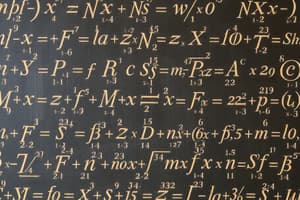Podcast
Questions and Answers
What is the significance of mathematical language in word problems?
What is the significance of mathematical language in word problems?
- It confuses students and makes problem-solving harder
- It adds complexity to the problems
- It is irrelevant in solving word problems
- It provides a clear way to describe the situation and relationships (correct)
In a word problem, what do mathematical symbols primarily serve as?
In a word problem, what do mathematical symbols primarily serve as?
- Alphabet of mathematics conveying meaning (correct)
- Storytelling tools
- Unnecessary additions
- Decorative elements
Why are word problems considered a cornerstone of elementary mathematics education?
Why are word problems considered a cornerstone of elementary mathematics education?
- To confuse students
- To make mathematics less practical
- To test language skills
- To apply mathematical concepts to real-world scenarios (correct)
What role does mathematical language play in solving word problems?
What role does mathematical language play in solving word problems?
Which term represents one of the key elements of mathematical language in a word problem about apples?
Which term represents one of the key elements of mathematical language in a word problem about apples?
Why are mathematical symbols described as the alphabet of mathematics?
Why are mathematical symbols described as the alphabet of mathematics?
Flashcards are hidden until you start studying
Study Notes
Mathematical Language: Unlocking Meaning in Word Problems and Symbols
Mathematical language isn't just about numbers and equations; it encompasses a rich vocabulary and representations that empower us to solve problems and communicate ideas. In this exploration, we'll delve into the significance of mathematical language in word problems and the ubiquitous symbols that are the backbone of mathematical discourse.
Mathematical Language in Word Problems
Word problems, also known as story problems, are a cornerstone of elementary mathematics education. They present students with scenarios that require them to apply mathematical concepts to find a solution. Mathematical language is essential in word problems because it provides a clear and precise means to describe the situation and the relationships between the variables involved.
Consider the following example:
Problem: A farmer has 150 apples and sells (\frac{2}{5}) of them at the market. How many apples does the farmer have left?
Here, the key elements of the mathematical language are "apples," "sells," and the fractional representation of the number of apples sold ((\frac{2}{5})). These words and symbols convey the information needed to solve the problem.
Mathematical Symbols
Mathematical symbols are the alphabet of mathematics, as they convey meaning in a precise and concise manner. A few core symbols include:
- Positive and negative signs: (+) and (-) are used to denote addition and subtraction, respectively.
- Multiplication symbol: (\times) or (\cdot) indicates the multiplication operation.
- Division symbol: ÷ or / represents the division operation.
- Equality symbol: (=) indicates that two expressions are equal.
- Greater-than and less-than symbols: (>) and (<) denote the relationships of being greater than and less than, respectively.
- Fraction bar: (\frac{}{}) is used to write fractions.
- Parentheses: (()) group expressions to indicate the order of operations.
These symbols, in conjunction with mathematical language, help us express and solve mathematical expressions and problems.
The Synergy Between Mathematical Language and Symbols
Mathematical language and symbols work hand-in-hand to communicate mathematical ideas and concepts. Consider the following expression: (7 - 3 \cdot 2 + 4). Here, the mathematical language tells us that we are subtracting 7 from the result of multiplying 3 and 2, and then adding 4. The symbols ((-), (\cdot), (+)) provide a concise and precise representation of the operations involved.
Challenges and Improvements
Many students struggle with understanding mathematical language and symbols, which can impede their ability to solve problems and understand mathematical concepts. Researchers and educators are continually exploring ways to improve students' understanding of mathematical language. For example, some schools are implementing the use of real-life contexts and visual representations in their mathematics curriculum to help students better comprehend mathematical concepts.
By understanding the significance of mathematical language and symbols, we can enhance our grasp of mathematical concepts and improve our problem-solving skills. Through practice and exposure to a range of mathematical contexts, we can develop fluency in this vital language, opening the door to a world of possibilities in mathematics and beyond.
Studying That Suits You
Use AI to generate personalized quizzes and flashcards to suit your learning preferences.




